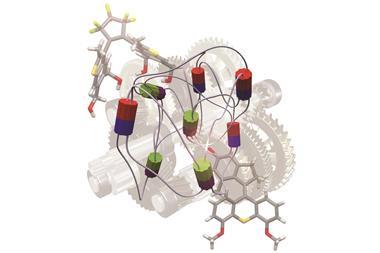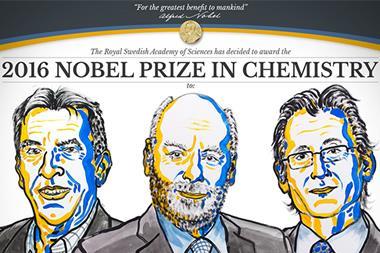Metal complexation can speed up molecular motor 32 times
‘We’ve come up with a way to switch gears in nanocars,’ says Sander Wezenberg, a postdoc at the University of Groningen in the Netherlands. Wezenberg is talking about a molecular motor made in Nobel prize winner Ben Feringa’s group that can now be shifted into top gear on demand. By adding a metal to the motor it can be accelerated up to 32 times its normal speed and is the first time dynamic control over the speed of rotation of a molecular motor has ever been demonstrated.

The motor has the classic shape of Feringa’s ‘windmills’, known as overcrowded alkene rotary motors. These windmills are not activated by wind, but light. A few months ago, the team designed a new type of motor sensitive to visible light. To do so, they incorporated two coordinating nitrogen atoms in its lower half and then attached a ruthenium complex to them. ‘We were surprised to see the motor was not only activated by visible light, but also rotated much faster. It was serendipity,’ says Wezenberg. ‘Then we thought about controlling this metal complexation and making it reversible, like a switch.’
Researchers found that certain metals, like zinc, palladium and platinum, could act as regulators. When they coordinate to the windmill, they induce a structural change that increases the rotational speed. ‘Platinum gives us the highest speed,’ says Wezenberg. ‘We can remove the metal adding competing ligands, and then turn the switch back on adding metal again.’ This gives chemists a level of control that was unprecedented in molecular machines. Being able to tune the speed of the motors opens a wide range of opportunities. ‘These motors can be used to power small devices or tiny robots. We envision molecular machines with higher levels of complexity,’ comments Wezenberg.
Steve Goldup, who researches interlocked molecules and molecular machines at the University of Southampton, says ‘this is a real breakthrough. Until now, different speeds could only be achieved designing different motors from scratch. Now, they can tweak the speed without changing the chemical structure of the motor.’ Goldup ponders the possibilities of this discovery. ‘Perhaps we could modify the speed by changing the ligands around the metal, or modifying its oxidation state. In the latter case, the speed of the nanomotor could then be adjusted simply by applying a voltage to the system.’
Goldup also finds fascinating how ‘Feringa makes it look really easy to achieve, when it’s actually really complicated. The simplicity of the solution belies the difficulty of the problem.’
References
A Faulkner et al, J. Am. Chem. Soc., 2016, DOI: 10.1021/jacs.6b06467

















No comments yet